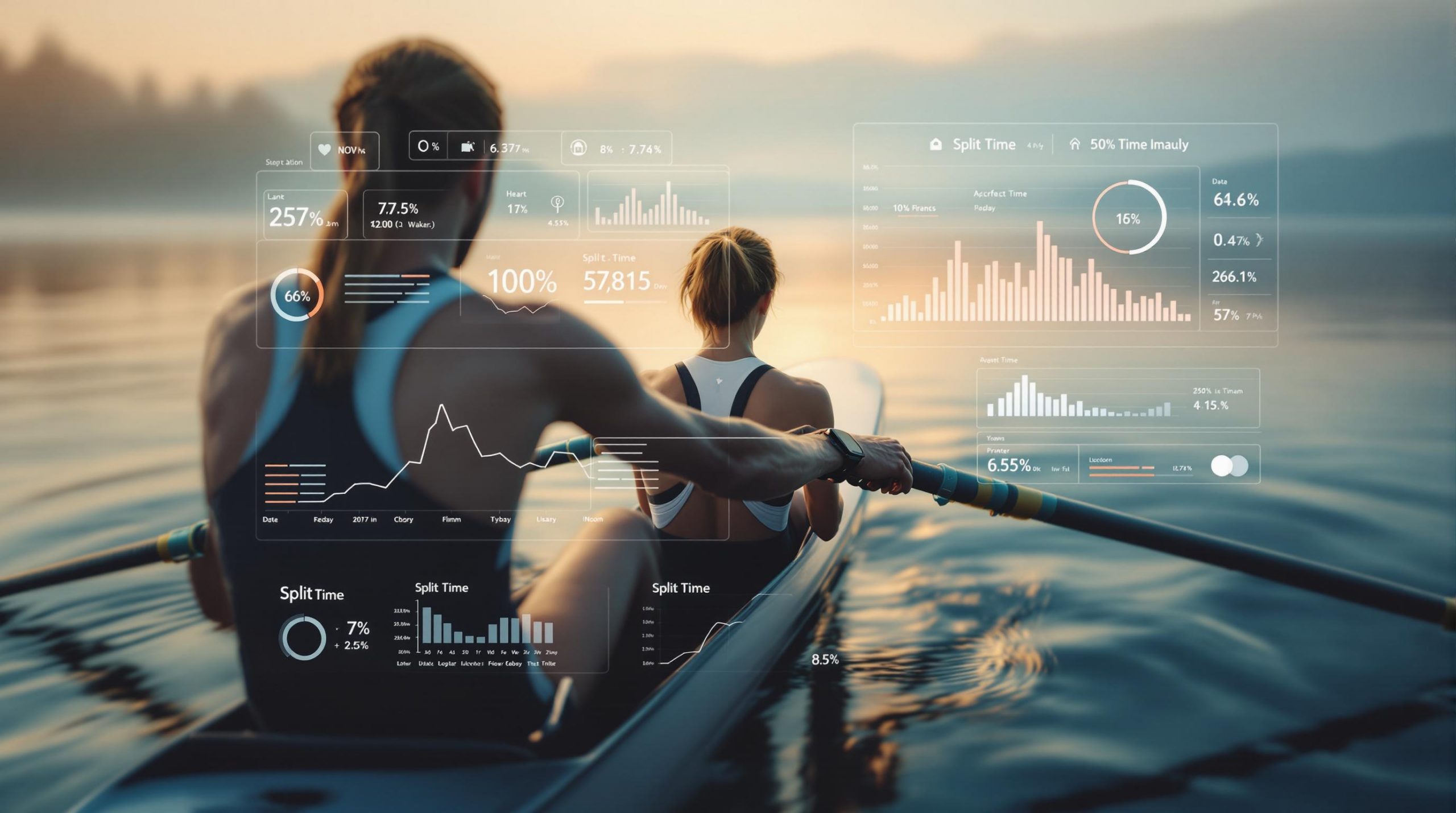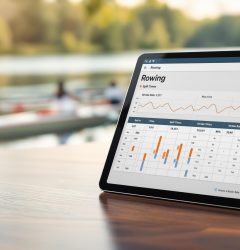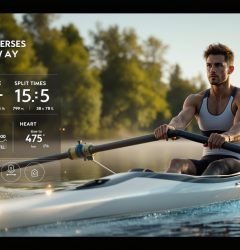03 Jan

- Use Heart Rate Zones: Train smarter by targeting specific heart rate zones for recovery, endurance, and power.
- Track Performance Trends: Analyze metrics like power output, consistency, and endurance to adjust your training.
- Balance Stroke Rate & Power: Focus on efficiency by refining stroke rate (18-24 SPM) and power output (180-200W).
- Refine Technique: Use data to perfect your stroke efficiency and power curves.
- Optimize Interval Training: Tailor intensity and recovery phases based on split times and heart rate data.
- Set Benchmarks: Compare workouts over time to measure progress and identify areas for improvement.
- Customize Training Plans: Use data to create personalized programs that align with your goals.
- Analyze Power Reports: Focus on maintaining steady power output to improve efficiency.
- Plan with a Calendar: Structure your weekly workouts to balance intensity, recovery, and endurance.
- Combine Data Sources: Merge metrics from tools like Concept2, ErgMonkey, and heart rate monitors for a complete performance view.
Quick Overview: Why This Matters
- Heart Rate Zones: Improve efficiency and avoid overtraining.
- Power & Stroke Data: Balance technique and output for better results.
- Long-Term Tracking: Identify trends and make informed adjustments.
- Integrated Tools: Combine multiple data sources for deeper insights.
By leveraging tools like ErgMonkey and Concept2 Logbook, you can track, analyze, and optimize your performance for consistent improvement. Start by focusing on one or two metrics, and expand as you grow comfortable with data-driven training.
Using 2K Average Split Time as Training Guide
1. Using Heart Rate Zone Analysis
Heart rate data can help you train smarter and improve your split times. By keeping track of your heart rate during workouts, you can focus on specific zones, each tailored to a different goal.
| Zone | % Max HR | Training Purpose | Effect on Split Times |
|---|---|---|---|
| 1 | 50-60% | Recovery & Warm-up | Builds endurance without overexertion |
| 2 | 60-70% | Endurance Building | Helps maintain a steady pace |
| 3 | 70-80% | Lactate Management | Boosts consistency in performance |
| 4 | 80-90% | High-intensity | Increases power and speed |
| 5 | 90-100% | Sprint Power | Maximizes peak speed potential |
Training within the right zones makes energy use more efficient, which directly translates to better and more consistent split times. Tools like ErgMonkey, available for $39.99/year, can track your zone distribution and provide detailed heart rate insights.
"Success in rowing comes from respecting zone boundaries and making thoughtful adjustments based on data insights. It’s not about pushing maximum effort every session", says Adam Harrison, Power House Rowing Club coach [3].
To get the most out of heart rate zone analysis:
- Focus on recovery in Zones 1-2 to avoid burnout.
- Gradually push harder in Zones 3-4 as your fitness level increases.
Using tools like ErgMonkey to consistently monitor your heart rate zones can help you make precise adjustments that improve your split times.
2. Monitoring Performance Trends
ErgMonkey’s Workout Trend Report helps rowers track their long-term progress with clear visualizations, making it easier to adjust and improve performance based on data.
| Metric | Description |
|---|---|
| Power Output | Watts/Rating ratio shows how efficient each stroke is. |
| Consistency | Variations in split times indicate pacing issues. |
| Progress | Monthly averages reveal overall improvement. |
| Endurance | Distance covered reflects stamina levels. |
These metrics provide the tools you need to refine your training and steadily lower your split times.
"Tracking split time gauges speed and efficiency, enabling adjustments for better performance." – Josh Ellenberg, Coach at Row House [1]
Here’s how to get the most out of tracking performance trends:
- Test standard distances like 500m or 1000m to set benchmarks.
- Use visualization tools to review your progress monthly.
- Make small, calculated adjustments to your training based on the data.
Platforms like rowsandall.com offer advanced tools for comparing your data over time. For instance, their Power Histogram shows that many rowers stay under 200W during steady-state training, offering a clear benchmark to aim for [2]. This kind of insight can help you define realistic training zones and set achievable goals.
Greg Smith also emphasizes the value of linking Concept2 machines to tracking apps. These apps provide detailed stats like strokes per minute and watts, which are key for measuring long-term progress [3].
3. Adjusting Stroke Rate and Power
Improving split times isn’t just about speed – it’s about finding the right balance between stroke rate and power output. Studies show that focusing on efficiency yields better results than simply trying to row faster.
| Component | Optimal Range | Impact on Performance |
|---|---|---|
| Stroke Rate | 18-24 SPM | Ideal for building endurance effectively |
| Power Output | 180-200W | Best suited for steady-state training goals |
| Split Time | 2:30-3:00/500m | Common starting range for most rowers |
To improve, work on perfecting your form at lower stroke rates while maintaining steady power output. For instance, lowering the stroke rate from 24 to 22 SPM and increasing power from 180 to 200 watts resulted in a 2-second improvement in split times over 40 minutes [1].
Here’s how to fine-tune your stroke rate and power:
- Focus on lower stroke rates (18-20 SPM) to sharpen your technique.
- Track your power output and compare split times weekly.
- Use consistent data tracking to identify your best training zones.
The drive phase – when you push with your legs and pull with your arms – is where you should concentrate your effort. Generating more force during this phase not only improves your rowing efficiency but also helps lower your split times [2].
Tools like ErgMonkey can help you monitor your progress and identify the most effective mix of stroke rate and power for your fitness level. By regularly analyzing this data, you can make informed adjustments that lead to noticeable gains in performance.
Once you’ve found the right balance, use these insights to further refine your rowing technique and maximize your results.
4. Improving Technique with Data
Adjusting stroke rate and power is important, but refining your technique through data analysis ensures each stroke maximizes efficiency. A strong technique ensures that the energy you generate directly contributes to faster split times.
Today’s rowing analytics tools offer detailed insights to help identify areas for technical improvement. The secret lies in understanding how different performance metrics interact:
| Metric | Target Range | Impact |
|---|---|---|
| Power & Force Curve | Bell curve, ±5% variation | Ensures even power distribution and stroke efficiency |
| Drive-Recovery Ratio | 1:2 | Highlights timing balance |
One of the best ways to work on technique is through low-rate rowing. Stick to a stroke rate of 18-20 SPM to build muscle memory and fine-tune your movements before increasing speed.
"You can’t row well high if you can’t row well low" [2]
When analyzing your technique data, focus on these important indicators:
- Split Time Consistency: Look for steady split times during longer, steady-state sessions.
- Power Application: Examine the shape of your force curve across varying stroke rates.
- Heart Rate Response: Notice how technical adjustments impact your cardiovascular efficiency.
For the best results, gather data from multiple sources to get a complete view of your technique. Start by recording baseline metrics, identify patterns like power consistency during the drive phase, and make focused adjustments to improve one element at a time.
Using data to refine your technique builds a strong base for interval training, which we’ll cover next.
5. Applying Data Insights to Interval Training
Interval training works best when informed by accurate data. Using heart rate zone analysis from Section 1, you can fine-tune both the intensity and recovery phases to get the most out of your workouts.
| Interval Type | Split Time Target | Recovery Ratio | Purpose |
|---|---|---|---|
| Short Power | 2-4% below steady state | 1:1 | Builds explosive power |
| Threshold | 1-2% below steady state | 1:2 | Improves lactate threshold |
| Endurance | At steady state | 1:3 | Increases aerobic capacity |
For instance, if your steady-state split is 2:00/500m, aim for 1:56-1:58 during short power intervals. Tools like ErgMonkey’s interval tracking can help you keep tabs on your performance across various intensity levels, ensuring you’re putting in the right amount of effort during each interval.
Here’s how to get the most out of your interval sessions:
- Track your split time and power output to spot when fatigue sets in.
- Monitor heart rate recovery between intervals to gauge your readiness for the next round.
- Keep power output consistent across all repetitions for steady progress.
sbb-itb-1725142
6. Comparing Workouts and Setting Benchmarks
Tracking and comparing workouts is key to improving split times. By focusing on specific metrics, rowers can pinpoint inefficiencies, fine-tune their technique, and work toward faster results.
Here’s how to structure your benchmarking process:
| Workout Type | Benchmark Metric | Tracking Frequency | Key Data Points |
|---|---|---|---|
| UT2 (40-min) | Average Split | Weekly | Heart Rate, Power Output |
| 2K Test | Split/500m | Monthly | Stroke Rate, Power Curve |
| Power Intervals | Peak Power | Bi-weekly | Time to HR Recovery, Split Variation % |
When comparing workouts, focus on specific metrics rather than overall results. For instance, during a 40-minute UT2 session, track your average split time and heart rate zones. This helps determine if improvements are due to better efficiency or simply more effort.
Tools like ErgMonkey make this process easier by offering features such as heart rate zone analysis, interactive performance graphs, and progress tracking. These tools allow you to visualize trends and identify areas for improvement across sessions.
When setting benchmarks, aim for small, manageable progress. For example, intermediate rowers could target reducing steady-state split times by 1-2 seconds per 500m over four weeks. This gradual approach helps avoid overtraining while building consistency.
Tips for maximizing benchmark data:
- Record baseline performance for each workout type.
- Set realistic improvement goals, such as a 0.5-1% gain per month.
- Use visualization tools to track progress over time.
- Adjust training intensity based on trends in your performance.
Keep in mind that fatigue often impacts performance more than technique. Factors like recovery time and training volume should be considered when evaluating your results.
Once benchmarks are in place, use these insights to customize your training plans and work toward your goals.
7. Tailoring Training Plans with Data
By examining performance metrics and trends, you can design a training program that aligns with your rowing goals and personal needs.
Analyzing your performance patterns allows you to pinpoint areas for improvement. This can be done by comparing workouts and evaluating heart rate zones to better understand your strengths and weaknesses.
Here’s a breakdown of how to use data in your training:
| Training Component | Key Metrics | When to Adjust | Action Items |
|---|---|---|---|
| Base Training | Heart Rate Zones, Split Times | Gaps in endurance | Adjust workout intensity |
| Power Development | Power Output, Stroke Rate | Drop in power | Incorporate technique drills |
| Recovery Periods | Heart Rate Recovery Time | Slow recovery rates | Modify rest intervals |
| Technical Work | Split Time Variation | Uneven power output | Emphasize low-rate work |
Focusing on efficiency at lower stroke rates is key to improving split times. Strengthening your foundation at these rates sets the stage for better overall performance.
Using data from tools like your ergometer and heart rate monitor provides a clearer picture of your workout intensity. This helps you identify the best training zones and power outputs for various sessions.
For a data-driven approach to training:
- Look at long-term trends to make gradual adjustments.
- Monitor split times across different stroke rates.
- Match heart rate data to your intended workout zones.
- Evaluate technique metrics during every session.
If you hit a plateau, shift your focus to refining technique at lower rates before ramping up the intensity.
Once your plan is customized, detailed power reports can help you fine-tune your performance even further.
8. Analyzing Power Reports
Power reports provide detailed insights into your rowing performance, helping you pinpoint inefficiencies and areas for improvement. Tools like ErgMonkey’s analytics features can highlight patterns that directly influence your split times and overall efficiency.
Key Metrics in Power Reports
| Metric | What to Look For | Impact on Split Times |
|---|---|---|
| Average Power | Consistent output | Keeps split times steady |
| Peak Power | Avoid excessive spikes | Highlights potential technique flaws |
| Power Distribution | Even pacing | Reflects effective pacing strategy |
| Use of Power | Optimal power zones | Boosts efficiency and endurance |
Instead of chasing high peak numbers, focus on maintaining consistent power output. Tools like Concept2’s ErgData and RP3 analytics offer a clear view of power trends over time, helping you identify patterns and areas for improvement.
Tips for Optimizing Power Output
- Compare power curves: Look for drop-offs during longer sessions to spot inefficiencies.
- Monitor power-to-heart-rate ratios: This helps gauge your endurance and efficiency.
- Identify efficient power zones: Use these zones to maximize your performance without overexertion.
ErgMonkey’s Standard plan integrates power data from Concept2 Logbook and RP3, making it easier to track trends across different machines and workout types.
Common Pitfalls to Watch For
Pay extra attention to power fluctuations during steady-state pieces. Uneven power application can waste energy and slow you down. Aim to smooth out your power curves for better results.
Best Practices for Analysis
- Review power reports weekly.
- Compare similar workouts to track progress.
- Analyze trends alongside heart rate data for a clearer picture of your performance.
Once you’ve gathered insights from your power data, combine this information with your training schedule to make consistent, structured improvements over time.
9. Using Calendar Planning
Calendar planning is a great way to organize training sessions and improve rowing performance. By structuring workouts, rowers can track progress and work towards better split times.
Weekly Training Structure
| Training Day | Focus | Heart Rate Zone |
|---|---|---|
| Monday | Steady State | Zone 2 (60-70% MHR) |
| Tuesday | HIIT | Zone 4 (80-90% MHR) |
| Wednesday | Recovery | Rest Day |
| Thursday | Technical | Zone 1 (50-60% MHR) |
| Friday | Sprint Work | Zone 5 (90-100% MHR) |
| Saturday | Recovery | Rest Day |
| Sunday | Long Distance | Zone 2 (60-70% MHR) |
Tips for Effective Planning
A well-planned training schedule balances different types of workouts – steady-state, high-intensity, technical, and recovery. This approach helps rowers improve without risking overtraining. Here are some key strategies:
- Regular Testing: Schedule tests to track progress and find areas to improve.
- Recovery Time: Use heart rate and power data to decide when extra rest is needed.
- Adjustments: Modify training intensity based on performance and recovery trends.
Tracking Progress
Using a calendar to plan and log workouts helps rowers see their progress over time. By comparing data from each session, you can identify what’s working and adjust your routine as needed.
If you notice a drop in performance or unusually high heart rates, it’s a sign to add more recovery time. This method keeps training effective and helps avoid burnout. Combining data from various sources can also give you a deeper understanding of your performance patterns.
10. Combining Data from Different Sources
Bringing together data from various sources provides a complete view of performance, making it easier to fine-tune strategies and improve split times. By analyzing metrics collectively, you can uncover patterns and opportunities that might go unnoticed when looking at individual data points.
Key Data Sources and Their Use
| Data Source | Metrics | Purpose |
|---|---|---|
| Concept2 Logbook | Split times, stroke rate, distance | Tracks historical performance |
| Heart Rate Monitor | Heart rate zones, recovery data | Adjusts training intensity |
| RP3 Platform | Power output, technique analysis | Improves technical efficiency |
| ErgMonkey | Workout comparisons, trend reports | Visualizes long-term progress |
Tools like ErgMonkey pull data from sources such as the Concept2 Logbook, RP3, and heart rate monitors. This allows for a unified view of metrics like split times, power output, and recovery data, making analysis more streamlined.
Managing Your Data
To ensure accurate insights, it’s important to regularly calibrate your equipment, stick to consistent recording methods, and clean up any anomalies in your data.
Using Data for Analysis and Coaching
Visualization tools like Rosandall help highlight trends by combining data from multiple sources. Coaches can then interpret these insights to make targeted adjustments, helping athletes achieve better split times and overall performance.
Conclusion
Data analysis has become a powerful tool for rowers aiming to improve their split times. By using modern analytics platforms and combining data from various sources, athletes can make decisions based on solid metrics instead of relying solely on intuition.
Here’s how data-driven training makes a difference:
- Performance Tracking and Analysis: Advanced analytics platforms allow rowers to compare workouts and spot trends, helping them uncover patterns and fine-tune their training for better results.
- Technical Efficiency: Keeping an eye on stroke rates while perfecting technique helps rowers build a strong base for lowering split times. This focused approach ensures consistent progress.
- Integrated Analysis: Merging data from tools like the Concept2 Logbook with heart rate monitors offers a complete picture, allowing for precise tweaks that lead to measurable improvements.
The key to future success in rowing lies in using data analysis wisely. Start simple – track basic metrics – and expand to more advanced tools as you grow comfortable with this approach.
FAQs
What heart rate zone should I be in rowing?
Training in the right heart rate zones allows rowers to use energy efficiently, build endurance, and improve split times. For steady-state workouts, aim to stay between 55-80% of your maximum heart rate for 30-80 minutes to enhance aerobic capacity.
Here’s an example breakdown for a 40-year-old rower with a maximum heart rate of 180 bpm:
| Zone | Heart Rate Range | Purpose |
|---|---|---|
| 1 – Light | 90-108 bpm (50-60%) | Recovery/Warm-up |
| 2 – Moderate | 108-126 bpm (60-70%) | Building a base |
| 3 – Steady | 126-144 bpm (70-80%) | Aerobic endurance |
| 4 – Hard | 144-162 bpm (80-90%) | Anaerobic threshold |
| 5 – Max | 162-180 bpm (90-100%) | Sprint/Power |
For UT2 (Utilization Training 2) sessions, it’s crucial to stay within your designated zone, even if you feel capable of pushing harder. This ensures steady progress without risking overtraining.
To find your personal zones, calculate your max heart rate using the formula 220 minus your age. Reassess every 8-12 weeks to account for changes in fitness. If you have a resting heart rate between 40-50 bpm, you may need to adjust these ranges.
Heart rate zones are just one tool for rowing performance. Combine them with other data points to refine your training and achieve better results.


